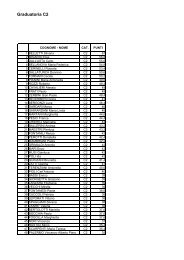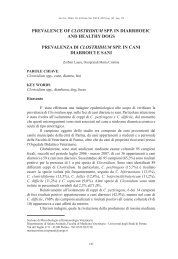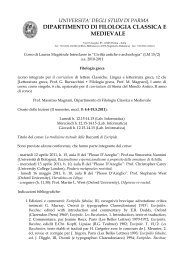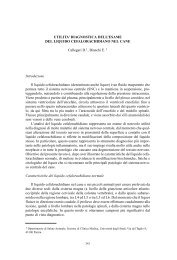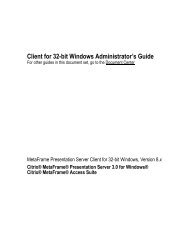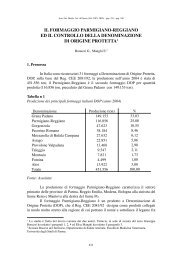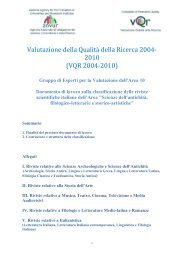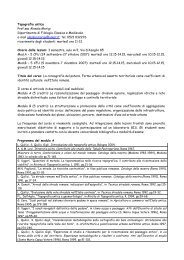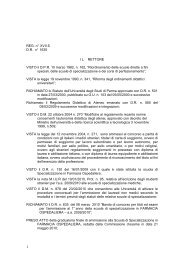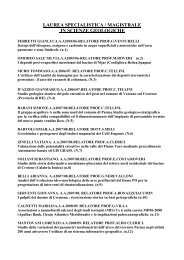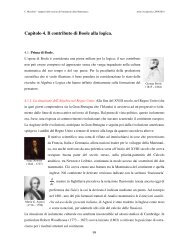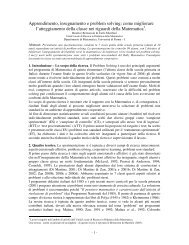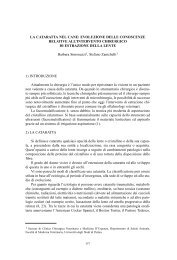MolECulAR ToXINoTYPINg oF CloSTRIDIuM PERFRINgENS ...
MolECulAR ToXINoTYPINg oF CloSTRIDIuM PERFRINgENS ...
MolECulAR ToXINoTYPINg oF CloSTRIDIuM PERFRINgENS ...
You also want an ePaper? Increase the reach of your titles
YUMPU automatically turns print PDFs into web optimized ePapers that Google loves.
Ann. Fac. Medic. Vet. di Parma (Vol. XXX, 2010) pag. 71 - pag. 80MOLECULAR TOXINOTYPING OF CLOSTRIDIUMPERFRINGENS CATTLE ISOLATES BY MULTIPLEX PCRTIPIZZAZIONE MOLECOLARE DI CEPPI DICLOSTRIDIUM PERFRINGENS ISOLATI DA BOVINIMEDIANTE MULTIPLEX PCRZerbini Laura, Ossiprandi Maria Cristina 1Structured SummaryObjectivesClostridium perfringens may be considered one of the most widespread pathogen,inhabiting the gastrointestinal tract of human beings and animals as well as terrestrialand marine environments. The objective of this study was to investigate the toxingene profile of cattle samples by PCR assays.MethodsA total of 104 faecal and intestine specimens were analyzed by culture assay. Overall,19 samples (18.3%) were positive for C. perfringens presence and were screened forthe identification of enterotoxigenic strains and the characterization of the toxinotypeby (a) a duplex PCR, which amplifies simultaneously the phospholipase C gene (plc)and the enterotoxin gene (cpe) fragments, and (b) a multiplex PCR, which detect alfa,enterotoxin, beta, epsilon, iota, and beta2 (cpa, cpe, cpb, etx, iap, and cpb2) toxinencodinggenes.ResultsAll isolates were type A (cpa/plc-positive) and cpe-negative by PCR assays. In2 samples, C. difficile was also isolated, resulting tcdA and tcdB negative. Other14 samples, C. perfringens-negative, resulted C. difficile-positive (tcdA and tcdBnegative) by culture assay.Clinical SignificanceWe can conclude that the molecular toxinotyping by PCR may provide an usefuland reliable tool for C. perfringens routine veterinary diagnostics and importantinformation about the distribution of genotypes.KeywordsClostridium perfringens, diarrhoeic/non-diarrhoeic, toxin gene profile, PCR assays1 Department of Animal Health, Section of Veterinary Microbiology and Immunology, Faculty of VeterinaryMedicine - University of Parma, Via del Taglio n° 10 - 43126 Parma - Italy.Sezione di Microbiologia ed Immunologia Veterinaria Dipartimento di Salute Animale, Facoltà diMedicina Veterinaria - Università degli Studi di Parma, Via del Taglio n° 10 - 43126 Parma - Italy, Tel.0521/032718 - mariacristina.ossiprandi@unipr.it71
Ann. Fac. Medic. Vet. di Parma (Vol. XXX, 2010) pag. 71 - pag. 80IntroductionClostridium perfringens is a Gram-positive, spore-forming, anaerobe bacteriumand an important human and veterinary enteropathogenic agent. Owing to its abilityto produce spores under adverse environmental conditions, it is one of the mostwidespread potential bacterial pathogen in nature as well as in the gastrointestinaltract of most animal species (Marks and Kather 2003; van Asten 2010). It has beenassociated with outbreaks of acute, often severe diarrhoea in humans, horses, dogs andcats. It causes gas gangrene and food poisoning in humans and several enterotoxaemicdiseases in domestic (Rood 1998) and wild animals (Uzal and Songer 2008).The production of four major toxins alpha (a, CPA), beta (b, CPB), epsilon (e, ETX)and iota (i, ITX) allows the discrimination into five types from A to E (Schotte et al2004; Lebrun et al 2007). This bacterium can produce at least 15 different toxins,helping to explain its ability to cause a broad array of enteric and histotoxic infections(Table 1) (Songer and Miskimins 2005; Lebrun et al 2007).In veterinary medicine, each types has been linked to specific diseases (Schotte etal 2004). C. perfringens enterotoxin (CPE) serves as an additional virulence factorwhich is believed to cause enteritis in pigs, cats and dogs (Schotte et al 2004).In 1997, a formerly unknown toxin of C. perfringens and its encoding gene(originating from a strain isolated from a piglet suffering from necrotic enteritis)were described. The 27.6 kDa toxin was initially thought to be a digestion productof the 34.8 kDa b-toxin (Lebrun et al 2007) but its amino acid sequence showedno significant homology with the sequence of the b-toxin (only 15% identity) orwith any other known protein sequence. The newly described toxin was neverthelesstermed b2 and its encoding gene cpb2, since the toxin displayed similar biologicalactivity as the b-toxin (Lebrun et al 2007).The CPB2 is postulated to play a role in C. perfringens neonatal enteritis in pigs(Gibert et al, 1997), typhlocolitis in horses and dogs, cattle enterotoxemia andgastrointestinal disease in man (Lebrun et al 2007).Type A strain, that produces only CPA among the major toxins, is a member ofthe normal flora of warm-blooded animals and is recovered from environmentcontaminated by faeces. However, when properly genetically equipped and placed inopportune situations, it can cause gas gangrene, food poisoning, and gastrointestinalillness in humans, necrotic enteritis in chickens, necrotizing enteritis in piglets, andabomasitis, tympany, and haemorrhagic enteritis in calves (Ferrarezi et al 2008).Gram-positive bacilli are often found on the mucosa and in the submucosa (Songerand Miskimins 2005).Strains of toxin type B-E are less common in the intestinal tracts of animals and canoccasionally be found in the environment in areas where the diseases produced bythese organisms are enzootic. They are, thus, considered frank pathogens (Ferrarezi etal 2008). Enteritis and enterotoxemia can be produced in calves by all C. perfringenstoxinotypes.Clostridial infections of the gastrointestinal tract of calves remain a commonproblem, in spite of the widespread availability of effective immunoprophylacticproducts. Neonatal infection by C. perfringens type C is widely recognized, and,like other infections by toxin types of C. perfringens, type C may colonize rapidly72
Ann. Fac. Medic. Vet. di Parma (Vol. XXX, 2010) pag. 71 - pag. 80Table 1 Diseases caused by toxin types of Clostridium perfringensToxin type DiseasesMajor toxinsABCMyonecrosis, food poisoning, necrotic enteritis in fowl,enterotoxemia in cattle and lambs, necrotizing enterocolitisin piglets; possibly equine colitis, canine haemorrhagicgastroenteritisDysentery in newborn lambs, chronic enteritis in older lambs(“pine”), haemorrhagic enteritis in neonatal calves and foals,haemorrhagic enterotoxemia in adult sheepEnteritis necroticans (pigbel) in humans, necrotic enteritis infowl, haemorrhagic or necrotic enterotoxemia in neonatal pigs,lambs, calves, goats, foals, acute enterotoxemia (“struck”) inadult sheepAlphaAlpha, beta,epsilonAlpha, betaDEnterotoxemia in lambs (“pulpy kidney”) and calves, enterocolitisin neonatal and adult goats, possibly enterotoxemia in adultcattleAlpha, epsilonEEnterotoxemia likely in calves and lambs, enteritis in rabbits;host range and disease type unclearAlpha, iotaSonger J. G. and Miskimins D.W. (2005). Anaerobe 11, 290-294Materials and MethodsSamples. A total of 104 samples (94 faeces and 10 intestines) were collected, usinga stratified random sampling, from different farms in the area of Parma (Italy) duringthe period end of 2008 to end of 2010: 62 faeces belonged to non-diarrhoeic animals(25 dairy cows, 19 pregnant heifers, 13 heifers and 5 calves) and 41 faecal andintestine samples belonged to diarrhoeic subjects (27 calves, 11 cows and 3 heifers).Assays were performed on faecal and intestine specimens within 3 hours from thecollection. After analysis, samples were immediately stored at -20°C.Isolation and identification of C. perfringens strains. All faecal and intestinalsamples were cultured onto prereduced blood agar plates, containing vitamine K,sheep blood and haemin (Schaedler agar, Oxoid, Basingstoke, Hampshire, England),and at the same time inoculated in cooked meat broth (Oxoid, England). Plateswere incubated in anaerobic conditions at 37°C for 48-72 hours. After 72 hours ofincubation in cooked meat broth, the samples were subjected to heat shock for sporeselection and then cultured onto Schaedler agar. Isolates which were anaerobic,Gram-positive, rod-shaped, and produced a double zone of haemolysis on blood werepreliminarily considered to be C. perfringens.The species identification was confirmed through the Rapid ID32A assay (bioMérieuxSA, Marcy-l’Etoile, France). All isolates were stored on cryopreservation beads (MASTDiagnostics, D.I.D, Diagnostic International Distribution S.p.A., Italy) at -70°C.74
Ann. Fac. Medic. Vet. di Parma (Vol. XXX, 2010) pag. 71 - pag. 80Reference strains. C. perfringens cpa+/cpe+, kindly provided by Istituto Superiore diSanità in Rome (Italy), was utilized as positive control for duplex PCR. C. perfringensATCC12917, NCTC8346, ATCC373, and ATCC27324 were used as cpa+/cpe+,cpa+/etx+, cpa+/cpb+/cpb2+ and cpa+/iap+/cpe+/cpb2+ controls, respectively, formultiplex PCR genotyping reactions.DNA extraction. For each C. perfringens strain, a 100-ml suspension of cells insterile water was vortexed, incubated at 100°C for 5 min., and centrifuged at 12,000g (Microliter Centrifuge, Hermle Z 233 M-2, Delchimica Scientific Glassware s.r.l.)for 2 min. An aliquot (5 ml) of this extracted DNA was used as template in PCRgenotyping.Duplex PCR for the C. perfringens phospholipase C and CPE encoding genes.Two sets of primers, which amplify simultaneously the 283 bp C. perfringensphospholipase C gene (plc) and the 426 bp enterotoxin gene (cpe) fragments,were used as previously described by Fach and Popoff (1997). Amplified productswere subjected to 1.5% agarose gel electrophoresis (120 V, 1 h) and visualized byethidium bromide staining and ultraviolet light exposure.Multiplex PCR for the C. perfringens toxins encoding genes. All C. perfringensisolates were also PCR-screened for the detection of alfa (cpa), beta (cpb), epsilon(etx), enterotoxin (cpe), iota (iap), and beta2 (cpb2) toxin encoding genes, asdescribed by Baums et al. (2004). The reaction products were subjected to agarosegel electrophoresis as mentioned above.ResultsOverall, 19 (18.3%, 95% C.I. 11.7% to 26.6%) of the 104 samples resulted C.perfringens positive by culture analysis. In one calf, C. perfringens was isolatedfrom the faecal and the intestine sample. All C. perfringens-positive specimensbelonged to diarrhoeic animals. In 2 faecal samples of calves, C. difficile wasalso isolated. These strains resulted tcdA and tcdB negative by the duplex PCR,previously described by Spigaglia and Mastrantonio (2002). Other 14 samples, C.perfringens-negative by culture assay, were positive for C. difficile (tcdA and tcdBnegative). Out of the 16 C. difficile isolates, 14 (87.5%) belonged to non-diarrhoeicdairy cows.All C. perfringens isolates were type A (cpa/plc-positive) by duplex and multiplexPCRs. All samples (15 faeces and 4 intestines) belonged to diarrhoeic animals (15calves, 2 cows and 1 heifer). Sixteen of the 19 C. perfringens-positive isolates(84.2%) were from calves. In particular, 55.6% of diarrhoeic calves (n=15 of 27)yielded isolates of C. perfringens.None of the 19 strains were enterotoxin-positive (plc+/cpe-) by duplex PCR. Thisresult was confirmed by multiplex PCR assay (cpa+/cpe-), where other toxin genesweren’t revealed (Figure 1).75
Ann. Fac. Medic. Vet. di Parma (Vol. XXX, 2010) pag. 71 - pag. 80Figure 1: Multiplex PCR typing of selected Clostridium perfringens isolatesLanes 1-7: type A strains (cpa+); lane 8: C. perfringens positive control (cpa+/cpb+/cpe+/etx+/iap+/cpb2+); lane 9: negative control (“0 DNA”); lane 10: molecular size markers (100 bpMolecular Ruler, Biorad, Italy).DiscussionC. perfringens is commonly found in soil samples and is also readily found inintestinal contents of healthy humans and other animals (Ferrarezi et al 2008).C. perfringens type A, that is often responsible for gas gangrene (myonecrosis) andfoodborne illness in humans (Ferrarezi et al 2008), produces CPA but can also produceseveral of the non-typing toxins, including CPE and CPB2. CPE is responsible forhuman gastrointestinal disease and also has been associated with diseases in dogs,horses, pigs, and several other animal species, including one case of enteritis causedby C. perfringens type A cpe-positive in a goat (Uzal et al 2008). Isolation ofnon-enterotoxigenic type A strains from a diarrhoeic specimen does not precludeinvolvement in disease, because there is a plethora of other virulence factors thathave not been evaluated. One of these virulence factors is the recently characterizedC. perfringens CPB2, which has been also associated with both necrotic enteritis inpiglets and equine typhlocolitis (Bueschel et al 2003; Baums et al 2004).In this study, about 55.6% of diarrhoeic calves (n=15 of 27) yielded isolates of C.perfringens, while no isolation was obtained from the 5 non-diarrhoeic calves tested.This difference is statistically significant (one-tailed Fisher’s P= 0.031). This highrate of recovery from diseased animals is not surprising, because they had diarrhoea76
Ann. Fac. Medic. Vet. di Parma (Vol. XXX, 2010) pag. 71 - pag. 80and strains of type A are found normally in the intestine, even in neonates, and somecontend that isolation of these organisms from calves with enteritis should not begiven etiologic significance. However, it is useful to view this from the perspectivethat types B-E are defined by production of beta, epsilon, and iota toxins, while typeA is a repository for all those strains which do not produce these toxins. Insufficientattention has been given to the possible action of alpha toxin in the gut. Furthermore,production of other potential virulence factors might set apart groups of isolatesassociated with specific syndromes which are now considered to be idiopathic. It isalso possible that strains normally resident in the gut produce the observed infectionsinto upper small intestine. There is little concrete information on the pathogenesisof type A enteric infections in calves. Disease is sometimes compatible with theaction of a haemolytic toxin in the circulation, causing intravascular haemolysis andcapillary damage, inflammation, platelet aggregation, shock, and sometimes-fatalcardiac effects.Alpha toxin can sometimes be found in the intestinal contents of animals with naturallyoccurring enteric disease, and is an important factor in pathogenesis of myonecrosis.Little is known of the permeability of the intestine to alpha toxin, but it may be avirulence factor in cases of presumed enterotoxemia (Songer and Miskimins 2005).Moreover, we assessed the toxinotype of the 19 (18.3%) C. perfringens isolates from104 diarrhoeic and non-diarrhoeic faecal and intestine samples.All 19 C. perfringens strains were isolated, as above mentioned, from diarrhoeicsubjects and they were type A by multiplex PCR, containing amplicons of plc/cpa,corroborating the results of others (Ferrarezi et al 2008). None of isolates containedcpe or others toxin-encoding genes. No strain of C. perfringens type A CPB2 toxingene positive was isolated.All non-diarrhoeic dairy cow samples resulted C. perfringens-negative, but C. difficilewas frequently isolated (22.6%: n=14 of 62).In conclusion, multiplex PCR assay for the detection of major toxin-encoding genesof C. perfringens is highly specific, and more rapid and considerably less expensivethan the mouse neutralization test or other in vivo methods. Moreover, the PCR assayeliminates the humanitarian concerns which accompany animal-based testing, andeliminates concerns about lack of availability of standard anti-toxins. PCR genotyping(Uzal et al 2008) provides a useful alternative to in vivo toxin neutralization tests fortyping of C. perfringens isolates and can detect the CPB2 gene.Multiplex PCR may provide an useful and reliable tool for C. perfringens genotypingin routine veterinary diagnostics, providing the final piece of information needed toestablish a diagnosis. The identification of C. perfringens toxinotypes can be criticalfor epidemiological studies, prophylaxis programs, and to formulate strategies forcorrect use of vaccines. However, a phenotypic characterization is required beforedrawing conclusions about the functionality of a particular toxin in the disease.At present, the most prominent needs are consistent reproduction of the disease,elucidation of virulence attributes, and development and application of preventionand control strategies (Songer and Miskimins 2005).77
Ann. Fac. Medic. Vet. di Parma (Vol. XXX, 2010) pag. 71 - pag. 80AcknowledgementsThe authors wish to thank Mrs. Cinzia Reverberi and Mr. Roberto Lurisi for theirtechnical support.References1. Baums C.G., Shotte U., Amtsberg G., Goethe R. (2004): Diagnostic multiplexPCR for toxin genotyping of Clostridium perfringens isolates. VeterinaryMicrobiology 100, 11-16.2. Bueschel D.M., Jost B.H., Billington S.J., Trinh H.T., Songer J.G. (2003): Prevalenceof cpb2, encoding beta2 toxin, in Clostridium perfringens field isolates:correlation of genotype with phenotype. Veterinary Microbiology 94, 121-129.3. Duncan C.L., Strong D.H. (1986): Improved medium for sporulation of Clostridiumperfringens. Journal of Applied Microbiology 16, 82-89.4. Fach P., Popoff M.R. (1997): Detection of enterotoxigenic Clostridium perfringensin food and fecal samples with a duplex PCR and the slide latex agglutinationtest. Applied and Environmental Microbiology 63, 4232-4236.5. Ferrarezi M.C., Cardoso T.C., Dutra I.S. (2008): Genotyping of Clostridium perfringensisolated from calves with neonatal diarrhea. Anaerobe 14, 328-331.6. Gibert M., Jolivet-Reynaud C., Popoff M.R. (1997): Beta2 toxin, a novel toxinproduced by Clostridium perfringens. Gene 203, 65-73.7. Lebrun M., Filée P., Mousset B., Desmecht D., Galleni M., Mainil J.G., LindenA. (2007): The expression of Clostridium perfringens consensus beta2 toxin isassociated with bovine enterotoxemia syndrome. Veterinary Microbiology 120,151-157.8. Marks S.L., Kather E.J. (2003): Bacterial-associated diarrhea in the dog: a criticalappraisal. Small Animal Veterinary Clinic 33, 1029-1060.9. Rood J.I. (1998): Virulence genes of Clostridium perfringens. Annual Review ofMicrobiology 52, 333-360.10. Schotte U., Truyen U., Neubauer H. (2004): Significance of b2-toxigenicClostridium perfringens infections in animals and their predisposing factors - AReview. Journal of Veterinary Medicine 51, 423-426.11. Songer J.G., Miskimins D.W. (2005): Clostridial abomasitis in calves: Case reportand review of the literature. Anaerobe 11, 290-294.12. Spigaglia P., Mastrantonio P. (2002): Molecular analysis of the pathogenicitylocus and polymorphism in the putative negative regulator of toxin production(TcdC) among Clostridium difficile clinical isolates. Journal of Clinical Microbiology40, 3470-3475.13. Uzal F.A., Songer J.G. (2008): Diagnosis of Clostridium perfringens intestinalinfections in sheep and goats. Journal of Veterinary Diagnostic Investigation20, 253-265.14. Uzal F.A., Fisher D.J., Saputo J., Sayeed S., McClane B.A., Songer G., TrinhH.T., Fernandez Miyakawa M.E., Gard S. (2008): Ulcerative enterocolitis in twogoats associated with enterotoxin- and beta2 toxin-positive Clostridium perfringenstype D. Journal of Veterinary Diagnostic Investigation 20, 668-672.78
Ann. Fac. Medic. Vet. di Parma (Vol. XXX, 2010) pag. 71 - pag. 80van Asten A.J.A.M., Nikolaou G.N., Gröne A. (2010): The occurrence of15. cpb2-toxigenic Clostridium perfringens and the possible role of the b2-toxin in entericdisease of domestic animals, wild animals and humans. Veterinary Journal183, 135-140.79
Ann. Fac. Medic. Vet. di Parma (Vol. XXX, 2010) pag. 71 - pag. 8080



